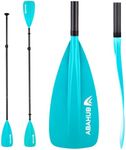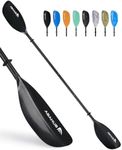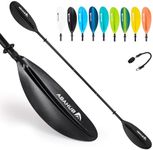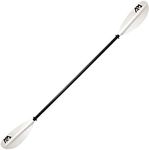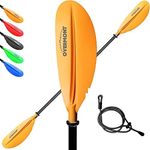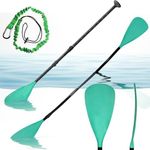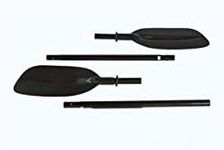Buying Guide for the Best Kayak Paddles
Choosing the right kayak paddle is crucial for an enjoyable and efficient kayaking experience. The paddle you select can significantly impact your comfort, speed, and control on the water. When selecting a kayak paddle, consider factors such as your paddling style, the type of kayaking you plan to do, and your physical characteristics like height and arm length. Understanding the key specifications of kayak paddles will help you make an informed decision that enhances your time on the water.LengthThe length of a kayak paddle is important because it affects your paddling efficiency and comfort. Paddle length is typically measured in centimeters and can range from around 210 cm to 260 cm. Shorter paddles are generally better for narrow kayaks and high-angle paddling styles, which are more aggressive and used for speed. Longer paddles are suited for wider kayaks and low-angle paddling, which is more relaxed and used for long-distance touring. To choose the right length, consider your height, the width of your kayak, and your paddling style. Taller paddlers or those with wider kayaks may need longer paddles, while shorter paddlers or those with narrower kayaks may prefer shorter paddles.
Blade ShapeBlade shape affects how the paddle interacts with the water and can influence your paddling style and efficiency. There are two main types of blade shapes: high-angle and low-angle. High-angle blades are shorter and wider, designed for more aggressive, powerful strokes, and are ideal for whitewater or fast-paced kayaking. Low-angle blades are longer and narrower, providing a more relaxed stroke, suitable for touring and long-distance paddling. Choose a blade shape that matches your paddling style and the type of kayaking you plan to do. If you prefer a leisurely pace, a low-angle blade might be best, while a high-angle blade suits those seeking speed and power.
MaterialThe material of a kayak paddle affects its weight, durability, and cost. Common materials include aluminum, fiberglass, and carbon fiber. Aluminum paddles are durable and affordable but tend to be heavier, making them suitable for beginners or casual paddlers. Fiberglass paddles offer a good balance of weight and durability, making them a popular choice for intermediate paddlers. Carbon fiber paddles are the lightest and most efficient, ideal for serious paddlers who prioritize performance and are willing to invest in a high-quality paddle. Consider how often you will paddle and your performance needs when choosing the material.
Shaft DesignThe design of the paddle shaft can influence comfort and control. Shafts can be straight or bent. Straight shafts are traditional and offer simplicity and versatility, suitable for most paddlers. Bent shafts have a slight angle that can reduce strain on the wrists and provide a more ergonomic grip, which is beneficial for long-distance paddling. Additionally, some shafts are adjustable in length or feathering angle, allowing for customization based on personal preference and paddling conditions. Consider your comfort and any physical limitations when choosing a shaft design.
FeatheringFeathering refers to the angle difference between the blades of a kayak paddle. Feathered paddles have blades that are offset, which can reduce wind resistance and improve efficiency. The feathering angle can usually be adjusted, with common settings ranging from 0 to 90 degrees. A higher feathering angle can be beneficial in windy conditions, while a lower angle or no feathering might be more comfortable for beginners. Consider the typical conditions you will paddle in and your comfort with adjusting the paddle when deciding on feathering.

